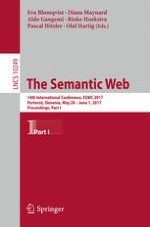2017 | OriginalPaper | Chapter
Embedding Learning for Declarative Memories
Authors : Volker Tresp, Yunpu Ma, Stephan Baier, Yinchong Yang
Published in: The Semantic Web
Publisher: Springer International Publishing
Activate our intelligent search to find suitable subject content or patents.
Select sections of text to find matching patents with Artificial Intelligence. powered by
Select sections of text to find additional relevant content using AI-assisted search. powered by
